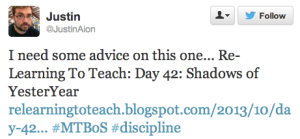Meg is striving for conceptual understanding, but her kids just aren’t getting it. However, they can follow the steps if they memorize “greatOR means ‘OR’ and less thAN means ‘AND.” Can you help her help these students?
So I’ll start off with the low so I can end on a high note. What are the three most dreaded words for a math teacher?
Absolute. Value. Inequalities.
I’ve tried 147 ways to teach these. This year I went with let’s shade our number line first, then write the inequalities to solve. Talked about kids on leashes at the mall can be five feet in front of mom or five feet behind. Talked about restraining orders mean you need to stay five feet away from me in both directions. Talked about how when we shade in between two numbers, we’re going to write our expression in between the two numbers. Talked about how I’ve shaded all the numbers below or to the left or, you know, less than -5, so I better write it as < -5 even though the original says >. Sent them home with homework which maybe 10% did. Next day: practice problems on individual whiteboards. (powerpoint file here)
Chaos ensued. Like I never even mentioned number lines the day before. Or that we’ve talked about writing inequalities when we’ve shaded between two numbers for two days before that. Maybe I really did forget to mention the need for two equations yesterday? That’s probably it. So let’s see why what we did wrong is wrong. Let’s see the correct way. Let’s go around to every group and have them say it needs to be < -7 instead of >. Have every group tell me to put the expression between the two numbers for < since I’ve shaded between the two numbers. Try another round.
Maybe 15% less chaos. Finally towards the end of eighth period (third section of Alg II w/ Trig. Which, yes, did I mention that? Second time around to see these absolute value guys.), I gave up. “Some teachers say a good way to remember is that greatOR means ‘OR’ and less thAN means ‘AND.’” I could feel Tina shuddering as I said it. I even made sure to say “some teachers” so that they wouldn’t think that I would ever say something like that. What happened next?
“Oh, that makes sense now!!” Maybe 80% got the next two examples correct, which was a vast improvement over the previous classes. “But they won’t remember it six months from now!” True. But obviously they didn’t remember my method 2 minutes later, so….
Scorecard: Conceptual learning: 0 Tricks: 1
Read about her successful PreCalc lesson and leave a comment on the original post: Highs and Lows: Even/Odd Functions and Absolute Value


